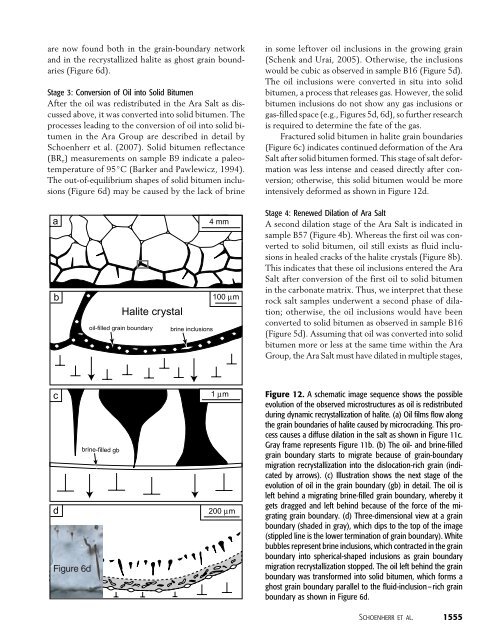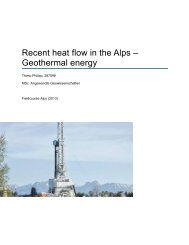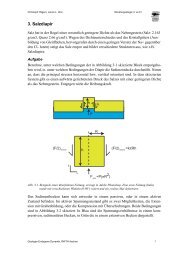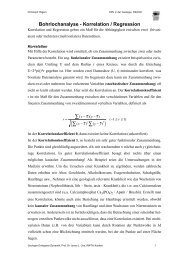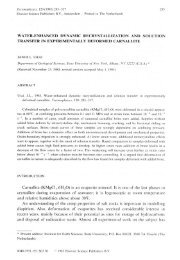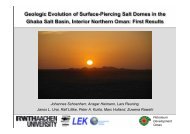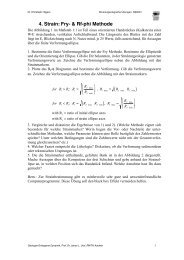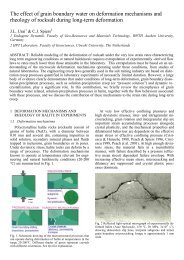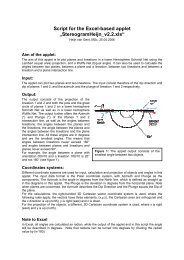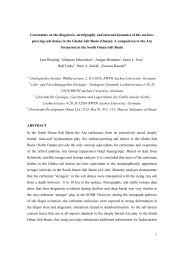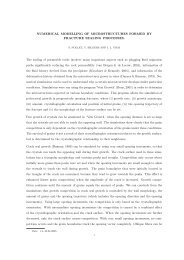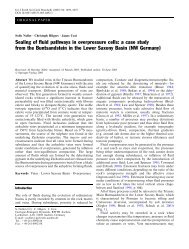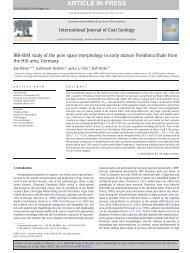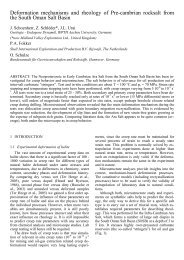Paper - RWTH Aachen University
Paper - RWTH Aachen University
Paper - RWTH Aachen University
You also want an ePaper? Increase the reach of your titles
YUMPU automatically turns print PDFs into web optimized ePapers that Google loves.
are now found both in the grain-boundary network<br />
and in the recrystallized halite as ghost grain boundaries<br />
(Figure 6d).<br />
Stage 3: Conversion of Oil into Solid Bitumen<br />
After the oil was redistributed in the Ara Salt as discussed<br />
above, it was converted into solid bitumen. The<br />
processes leading to the conversion of oil into solid bitumen<br />
in the Ara Group are described in detail by<br />
Schoenherr et al. (2007). Solid bitumen reflectance<br />
(BR r) measurements on sample B9 indicate a paleotemperature<br />
of 95jC (Barker and Pawlewicz, 1994).<br />
The out-of-equilibrium shapes of solid bitumen inclusions<br />
(Figure 6d) may be caused by the lack of brine<br />
in some leftover oil inclusions in the growing grain<br />
(Schenk and Urai, 2005). Otherwise, the inclusions<br />
would be cubic as observed in sample B16 (Figure 5d).<br />
The oil inclusions were converted in situ into solid<br />
bitumen, a process that releases gas. However, the solid<br />
bitumen inclusions do not show any gas inclusions or<br />
gas-filled space (e.g., Figures 5d, 6d), so further research<br />
is required to determine the fate of the gas.<br />
Fractured solid bitumen in halite grain boundaries<br />
(Figure 6c) indicates continued deformation of the Ara<br />
Salt after solid bitumen formed. This stage of salt deformation<br />
was less intense and ceased directly after conversion;<br />
otherwise, this solid bitumen would be more<br />
intensively deformed as shown in Figure 12d.<br />
Stage 4: Renewed Dilation of Ara Salt<br />
A second dilation stage of the Ara Salt is indicated in<br />
sample B57 (Figure 4b). Whereas the first oil was converted<br />
to solid bitumen, oil still exists as fluid inclusions<br />
in healed cracks of the halite crystals (Figure 8b).<br />
This indicates that these oil inclusions entered the Ara<br />
Salt after conversion of the first oil to solid bitumen<br />
in the carbonate matrix. Thus, we interpret that these<br />
rock salt samples underwent a second phase of dilation;<br />
otherwise, the oil inclusions would have been<br />
converted to solid bitumen as observed in sample B16<br />
(Figure 5d). Assuming that oil was converted into solid<br />
bitumen more or less at the same time within the Ara<br />
Group, the Ara Salt must have dilated in multiple stages,<br />
Figure 12. A schematic image sequence shows the possible<br />
evolution of the observed microstructures as oil is redistributed<br />
during dynamic recrystallization of halite. (a) Oil films flow along<br />
the grain boundaries of halite caused by microcracking. This process<br />
causes a diffuse dilation in the salt as shown in Figure 11c.<br />
Gray frame represents Figure 11b. (b) The oil- and brine-filled<br />
grain boundary starts to migrate because of grain-boundary<br />
migration recrystallization into the dislocation-rich grain (indicated<br />
by arrows). (c) Illustration shows the next stage of the<br />
evolution of oil in the grain boundary (gb) in detail. The oil is<br />
left behind a migrating brine-filled grain boundary, whereby it<br />
gets dragged and left behind because of the force of the migrating<br />
grain boundary. (d) Three-dimensional view at a grain<br />
boundary (shaded in gray), which dips to the top of the image<br />
(stippled line is the lower termination of grain boundary). White<br />
bubbles represent brine inclusions, which contracted in the grain<br />
boundary into spherical-shaped inclusions as grain boundary<br />
migration recrystallization stopped. The oil left behind the grain<br />
boundary was transformed into solid bitumen, which forms a<br />
ghost grain boundary parallel to the fluid-inclusion–rich grain<br />
boundary as shown in Figure 6d.<br />
Schoenherr et al. 1555


